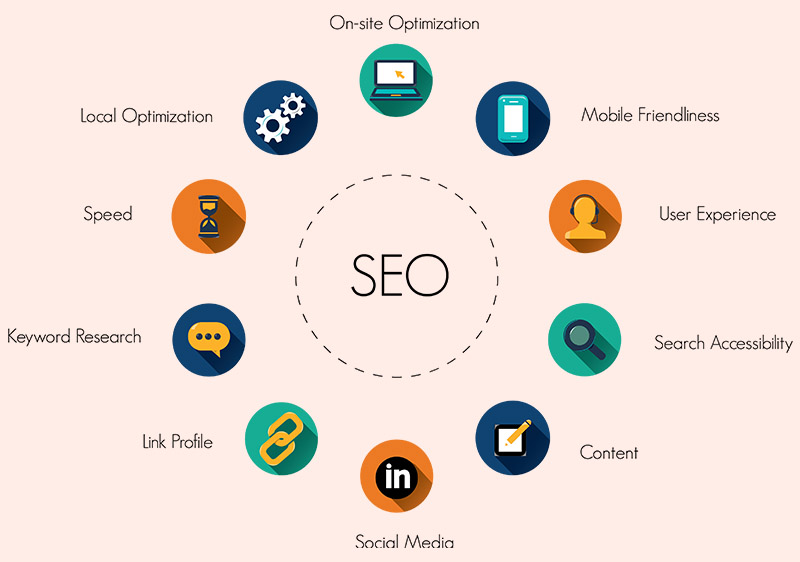
It is no secret that organic traffic is the lifeblood of many small businesses. The businesses that rank in the top three organic spots capture over 80% of the search traffic. If you're not in the top three, you're fighting for a meager 20% of search traffic. The secret to good organic rankings is that slow and steady wins the race. Businesses that had taken shortcuts prior to 2012 were brought back down to earth after Google cracked down with its Panda and Penguin updates. Resolve to try the longer term approach in 2013.
First, you need to understand what drives a businesses rankings: links and content. Great content on a brand new website has very little chance of ranking at all. Likewise, a well-linked site with content that's irrelevant to the searcher won't show in the search results. It's all about getting the right mix of quality links plus quality content. Most industry experts agree that 70% of a site's ability to rank comes from thedomain authority of sites linking to it. The other 30% comes from the content on the website.
The SEO in 20 Minutes A Day Program
1. Use Existing Search Data to Find Out What Questions People Want Answered
Since the objective is to get visitors to your website, focus your content on search terms that people use every day. The easiest ways to do this is to use keyword traffic tools to find search phrases to include in your content marketing. There are two ways to do this:
Use a competitor analysis tool to see which rankings your competitors have that you don't. There are many web graders available but most of them provide onsite SEO data. My firm offers a free web grader that provides off-site SEO data (links and keyword rankings).

Use a keyword research tool like Google Adwords keyword research. You can plug in examples of your industry words and Google will tell you how many people search on the phrase and other similar phrases.
In either case, you don't want to pick keywords that are difficult to rank on. Don't forget, the top three search results get 80% of the clicksso that's what you're shooting for.
2. Scout the Competition
A highly competitive keyword can take months or years to get to the top three, if you ever get there at all. So choose your keywords wisely. To get a measure of the competition on your choice keywords, place the keyword or phrase in quotes and run a Google search. This will tell you how many results there are for your exact keyword or keyword phrase (exact match results).
Assuming you manage a small business website, as a rough rule of thumb, you shouldn't pick a keyword that has more than 12,000 results.
Once you have your list of keywords, before you go any further, be sure to do a relevancy test on the keyword. Ask yourself "Does my product or service really answer the question being asked?" If it doesn't, strike it from your list and go on to the next keyword.
Build a list of 30-40 keywords that you can use for your content development for the next few weeks or months.
3. Create Brilliant Content
Easier said than done right? You can do it because you know your business and that makes you anauthority! Start by blogging on your website and applying to guest blog on other sites. Ready to become even more ambitious with your content? Here are some advanced, outside the box ideas that take more time, and a bit of trial and error, but the payoff is well worth the effort:
Video Blogs - My business partner and I recently began experimenting with video blogs and are very encouraged by the results.
The SEO value has been tremendous. We highly recommend this approach: We identify a keyword (using steps 1 and 2, above) and the questions people ask that are related to the keyword, then we brainstorm the answers. Next, we use Google Hangouts to produce a video in which we discuss the topic, working the keyword into the discussion, and provide answers to the questions so the video is relevant and helpful to people who are searching on the keyword. We do some quick edits in Camtasia and transcribe the video. You can transcribe it yourself or use a video transcription service like Wistia or Speechpad. Search engines cannot "read" your video so it's important to transcribe the video and provide the text that search engines can understand.
Graphics - Infographics were all the rage in 2012 and can still be a great way to visually provide valuable content that your target audience seeks. Again, make sure that you provide some text at the bottom of the graphic for the search engines.
Customer Interviews - This is essentially a hybrid of Blogs and Video Blog. Ask your customers to talk about your company, products/services and publish the text or video interview on your blog.
Be smart about the resources you have to help you with creating content. You might have a talented writer or a budding video producer in your midst that would love to take this on!
4. Tune Your Content
Once you have your content produced, you need to tune it for the two primary audiences:

End Users - The people you're trying to attract to your website Search Engines - Like Google and Bing End users really want to see nice images, frequent paragraph breaks, section headers, bullets and concise writing.
Search engines aren't quite as discerning when it comes to aesthetics but they do look forkeyword density, title tags, URLs, alt text of images and meta tags. Google now looks for authorship and schema.org to provide rich snippets in their search results. Set up Google+ authorship so you can link website content to your Google+ profile. Use schema.org to markup local, video, product and address information. When you use schema.org, search engines get structured information that helps improve search result quality. These extra steps can help you stand out in Google and other search engine results.
5. Promote and Track Your Content
Once the content is up on you site, you want to track the progress. Use Google Analytics to track the ranking of your site for the targeted keyword. Watch to see if it changes after you create your content (be sure to give it a few weeks).
Get the content off to the right start by getting your company to promote the content on social networks. That means tweeting and posting fromyour company's social media accounts and inviting interaction on your site by providing a place for people to comment. It also means asking your employees and friends to share your content on their own social media accounts and comment on your blog posts.
Conclusion
The program is not easy. BUT, because it's not easy, most small businesses don't to it. Once you write your first blog and produce your first video, it will be easier the next time around. Devote an average of 20 minutes a day to the program, and expect to see a steady improvement in your search rankings. Before long, your competitors will be tripping all over themselves trying to figure out how you passed them by!
Original Source: technorati.com















Post Your Comment
Comments